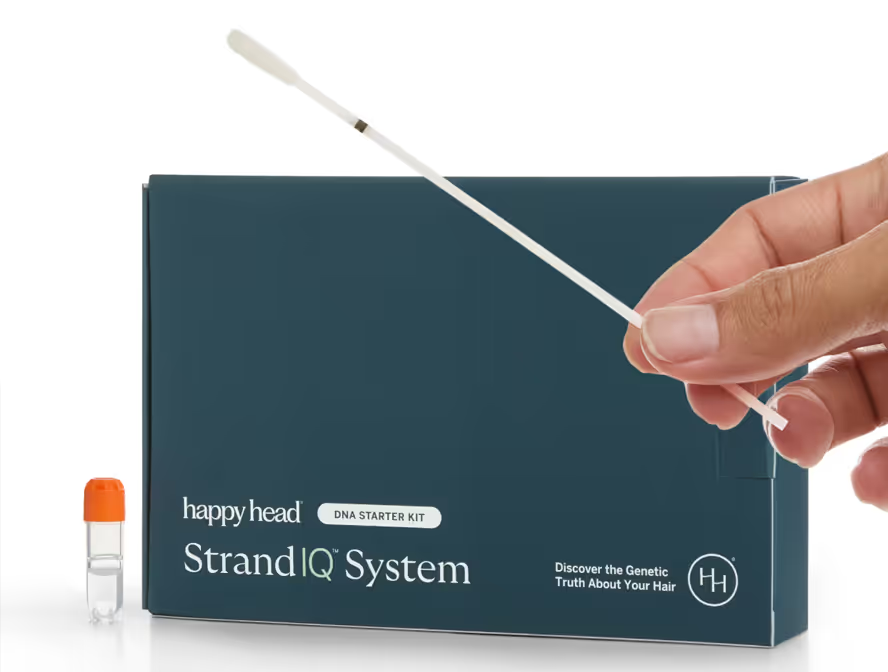Vitamin E is a fat-soluble antioxidant that plays a critical role in scalp and hair health. It helps protect follicle cells from oxidative damage, supports the scalp’s lipid barrier, and aids microcirculation—delivering nutrients and oxygen to the follicle base where growth begins.
If your genetics affect vitamin E absorption or recycling, your hair may be more vulnerable to oxidative stress, breakage, and inflammation-related thinning. Factors like poor fat absorption, gastrointestinal conditions, or low dietary intake can make these risks more apparent, especially if paired with environmental stressors like UV exposure or pollution.
How Vitamin E Supports Hair and Scalp Function
Vitamin E works on several levels to maintain strong, healthy hair:
- neutralizes oxidative stress that can weaken follicles and accelerate shedding
- maintains scalp lipids, protecting against dryness and irritation
- improves microcirculation, helping carry oxygen and nutrients to active hair follicles
Low levels of vitamin E may impact the appearance of hair strength and resilience, especially for those with genetic variants that reduce activity or transport efficiency.
The Role Genetics Play in Vitamin E Deficiency
Genetics can influence how efficiently your body absorbs, transports, and recycles vitamin E, which is crucial for maintaining scalp integrity and protecting hair follicles from oxidative stress.
Several mechanisms can contribute to a higher risk of functional deficiency:
- Variations in lipid metabolism genes – Because vitamin E is fat-soluble, variants affecting fat absorption or transport proteins can reduce its availability to the scalp and follicles.
- Reduced antioxidant recycling – Genes involved in antioxidant pathways may lower your body’s ability to regenerate vitamin E after it neutralizes free radicals, leaving hair follicles more vulnerable to oxidative damage.
- Heightened impact during stress or inflammation – When vitamin E processing is genetically less efficient, oxidative stress from UV exposure, pollution, or chronic inflammation can accelerate breakage, dryness, or thinning.
Identifying a genetic tendency toward low vitamin E activity allows for personalized nutrition and monitoring, helping protect your hair and scalp against long-term damage.
Recommendations Based on Genetic Risk
These tailored suggestions based on your Happy Head StrandIQ analysis-determined risk level can help protect your scalp and hair by optimizing vitamin E intake, absorption, and utilization.
Low Risk: Maintain Adequate Intake and Absorption
If your genetic profile suggests low risk for vitamin E deficiency, a balanced diet and basic topical care are typically sufficient to protect hair and scalp health:
- Focus on vitamin E-rich foods
Include avocados, peanuts, hazelnuts, sunflower seeds, whole grains, wheat germ, and vegetable oils (like sunflower or safflower oil). - Pair with healthy fats
Vitamin E is fat-soluble, so combining it with olive oil, yogurt, or nut butters can improve absorption and utilization. - Add topical support
Hair and scalp care products with vitamin E or tocopherol can help strengthen the lipid barrier and protect against dryness or environmental damage.
Medium Risk: Support Utilization and Guard Against Oxidative Stress
If you’ve been identified as being at a moderate genetic risk, your body may not absorb or recycle vitamin E as efficiently, requiring a more structured approach.
- Prioritize nutrient-dense sources
Include nuts, seeds, avocados, leafy greens, and vegetable oils in daily meals. Rotating multiple sources ensures a broader nutrient profile. - Incorporate targeted topicals
Regular use of vitamin E-enriched serums, scalp oils, or conditioners can bolster the skin barrier and reduce oxidative stress at the follicle level. - Address environmental stressors
Limit excessive sun exposure, pollution, and heat styling, as these factors accelerate oxidative damage when vitamin E processing is suboptimal. - Supplement with caution
Supplementation can be beneficial at this stage but should only be done under medical guidance, as excess vitamin E may interfere with blood clotting or other fat-soluble vitamins.
High Risk: Focus on Bioavailability, Protection, and Professional Monitoring
If your genetic profile indicates high risk for weak vitamin E processing, supporting long-term scalp health and hair resilience requires a targeted, proactive approach:
- Routine monitoring by a licensed healthcare provider
Work with your physician to check blood levels of vitamin E and related fat-soluble vitamins (A, D, and K) to identify any nutritional or wellness gaps early. - Consider supervised supplementation
Your doctor may recommend water-miscible or mixed tocopherol/tocotrienol supplements, which are absorbed more efficiently in individuals with fat metabolism concerns. - Incorporate multi-antioxidant support
Pair vitamin E intake with vitamin C, selenium, and polyphenols from foods or supervised supplements to improve antioxidant recycling and follicle protection. - Target gut health for absorption
Conditions affecting fat absorption, like mild gastrointestinal inflammation, can reduce vitamin E availability. Work with your doctor to create a plan that includes probiotics or digestive enzymes to support better uptake. - Structured environmental protection
High-risk individuals benefit from UV-blocking hair sprays, pollutant shields, or protective headwear to reduce the oxidative burden on scalp and hair.
Supporting Hair Growth Through Vitamin E
Maintaining healthy vitamin E levels can strengthen your scalp’s barrier function, improve follicle resilience, and reduce the risk of oxidative damage that leads to thinning or breakage. For those with genetic variants affecting vitamin E processing, a mix of nutrient-dense foods, healthy fats, topical care, and professional guidance offers the best path to long-term hair and scalp wellness.
Resources
StrandIQ SNP Marker Count: 19
StrandIQ Genes for Trait:
ALDH1A2, APOA5, BUD13-DT, CD36, CETP, CYP4F2, GGH, LIPC, LIPC-AS1, NCAN, NKAIN3, RNF215, SCARB1, SEC14L2, SF3A1, SLC39A1P1, TM6SF2, TTPA, ZPR1
References:
Al-Khelaifi, F., et al. (2019). Metabolic GWAS of elite athletes reveals novel genetically-influenced metabolites associated with athletic performance. Scientific Reports, 9(1), 19889. PMID: 31882771.
Benjamin, E.J., et al. (2013). Imputation of variants from the 1000 Genomes Project modestly improves known associations and can identify low-frequency variant-phenotype associations undetected by HapMap based imputation. PLoS One, 8(5), e64343. PMID: 23696881.
Borel, P., Desmarchelier, C. (2016). Genetic variations involved in vitamin E status. International Journal of Molecular Sciences, 17(12), 2094. PMID: 27983595.
Borel, P., Moussa, M., Reboul, E., et al. (2007). Human plasma levels of vitamin E and carotenoids are associated with genetic polymorphisms in genes involved in lipid metabolism. Journal of Nutrition, 137(12), 2653–2659. PMID: 18029479.
Civelek, M., Podszun, M.C. (2022). Genetic factors associated with response to vitamin E treatment in NAFLD. Antioxidants (Basel), 11(7), 1284. PMID: 35883775.
Ferrucci, L., et al. (2009). Common variation in the beta-carotene 15,15'-monooxygenase 1 gene affects circulating levels of carotenoids: a genome-wide association study. American Journal of Human Genetics, 84(2), 123–133. PMID: 19185284.
Galmés, S., Serra, F., Palou, A. (2018). Vitamin E metabolic effects and genetic variants: a challenge for precision nutrition in obesity and associated disturbances. Nutrients, 10(12), 1919. PMID: 30518135.
Lecompte, S., et al. (2011). Polymorphisms in the CD36/FAT gene are associated with plasma vitamin E concentrations in humans. American Journal of Clinical Nutrition, 93(3), 644–651. PMID: 21228269.
Major, J.M., et al. (2011). Genome-wide association study identifies common variants associated with circulating vitamin E levels. Human Molecular Genetics, 20(19), 3876–3883. PMID: 21729881.
Niforou, A., Konstantinidou, V., Naska, A. (2020). Genetic variants shaping inter-individual differences in response to dietary intakes—a narrative review of the case of vitamins. Frontiers in Nutrition, 7, 558598. PMID: 33335908.
This content, including StrandIQ™ DNA analysis reports and any Happy Head products and/or services referenced therein, is for informational and cosmetic purposes only. It is not intended to diagnose, treat, cure, or prevent any disease. This content does not constitute medical advice and should not be used to make healthcare decisions. References to prescription treatments are educational in nature. Always consult a licensed healthcare professional for any medical concerns or treatment decisions.








.avif)

